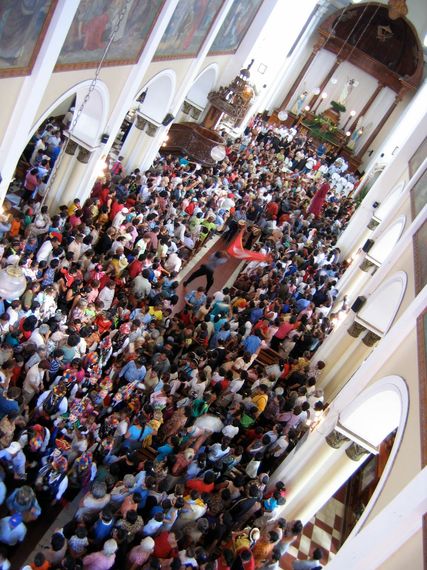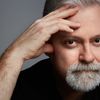 Exactly ten years ago, clinging to a rope in the belfry of the Basílica Menor de San Sebastián, Diriamba, Nicaragua, I looked down to see the Christ hanging above the altar, hands and feet nailed with barbs of sorrow to the Holy Rood. Flying a dozen feet upwards, drowning in the sound of the singing, of the bells, of the blood pounding in my head, I looked down to see waves of people reaching up to touch the saints as they passed in the plaza. I looked up to see the huge clappers inside the bells, felt weightless, and then, hurtling downwards, saw the lines of bullet holes pocking the belfry's inner walls.
Exactly ten years ago, clinging to a rope in the belfry of the Basílica Menor de San Sebastián, Diriamba, Nicaragua, I looked down to see the Christ hanging above the altar, hands and feet nailed with barbs of sorrow to the Holy Rood. Flying a dozen feet upwards, drowning in the sound of the singing, of the bells, of the blood pounding in my head, I looked down to see waves of people reaching up to touch the saints as they passed in the plaza. I looked up to see the huge clappers inside the bells, felt weightless, and then, hurtling downwards, saw the lines of bullet holes pocking the belfry's inner walls.
Latin America is a bloody clot of Life and Death, Good and Evil, Wealth and Extreme Poverty, Man and God. For me, this inspires a heightened awareness of possibility, an intensification of experience that renders emotions more vivid, the appreciation of the fragility of life more sanguine.
Nicaragua -- the birthplace of my wife's mother -- is a place for which I have profound affection, and to which I return as often as possible. Our winter 2006 visit coincided with the weeklong festival of San Sebastian. During the previous week, we had enjoyed a horse-drawn coach ride around the colonial city of Granada -- a town that has been dressed for wealthy travelers -- and boated on the fresh water of Lake Nicaragua -- a lake so large that you could drop Puerto Rico into it. We trekked up the paths surrounding the active cone of the Masaya Volcano, made our way through the bustling markets of Masaya and Jinotepe, and spent our last morning in La Boquita on a ten mile walk on the beach to the shore's point (which revealed another point beyond that) at dawn. All the while, we were treated to incredibly lavish and sumptuous meals prepared by our Tia Leyla as well as delicious foods in fine Nicaraguan restaurants. We were treated so wonderfully that our hearts were bursting.
Either it was a discarded bone needle of the sort used by fishermen to repair their nets, or it was a stingray's barb, a rusty nail -- whatever, the four inch long espina passed through my wife's foot like a red hot knitting needle through butter when she stepped on it in the Pacific surf.
The patriarch of the family there, Tio Ricardo, is one of the foremost horse trainers in Latin America. The horse is central to society there not just as a beast of burden, but also as a mark of culture and prestige. One day we attended the Ipica -- a huge equestrian festival -- in Diriamba where $100 workhorses were ridden proudly next to $150,000 show horses. Because of his personal charisma, character, and his talent as a horseman, Ricardo seems to know and be respected by everyone -- from the peasant driving his burrow down the street to the President of the country, Enrique Bolaños, to whom we were introduced at one of the house parties that Tio and Tia brought us to during the festival. We were honored that the president took time not only to meet us, but also to have an actual conversation with each of us.
She turned chalk white, one foot out of the water, the other in. "Don't move, I said." "I don't know what it is," she said. The pain moved across her face like a shadow. I bent down in the waves and felt for her foot as, reflexively, she lifted it.
The festival of San Sebastian celebrates the meeting of the patron saints of Diriamba (San Sebastian), Jinotepe (Santiago), and San Marcos (San Marco). Evidently, statues of San Sebastian and Santiago were en route from Spain when the boat carrying them capsized. Fishermen then found the statues floating in the ocean, dry and safe in sealed boxes, as close to each of their intended destinations as they could have been. The folklore surrounding them is that, with this history, they must be traveling companions, and very close friends. Each year San Sebastian invites both Santiago and San Marcos, as he is from another nearby town, to celebrate with him in Diriamba.
Blood poured out of both the top and the bottom of my wife's foot and into the water, on my hands, all over her suit. I checked the entry and exit wounds. Clean. I tore my shirt off and bound her foot. It stanched nothing. "I've got to get you to the house. Don't look at the blood," I said, trying to tie the shirt more tightly.
Faithful from each town carry the statues from Diriamba, Jinotepe, and San Marcos to Dolores, a town in the middle of all three Saints' homes, where the three meet and then parade back to Diriamba. A huge Mass is celebrated in the basilica there and everyone processes, carrying the saints' statues, accompanied by extravagant, beautiful dances and music. Children as young as four years old -- dressed up in elaborate costumes -- throw themselves into the moment. Faithful of all ages walk on their knees to fulfill promises to the saints. The incredible smells of fresh -- and delicious -- festival foods like picadillo, chicharrón, yuka, and nacatameles as well as of horses, people and the spent gunpowder of fireworks -- all overwhelm.
"I'm okay," she protested. "I can walk." Putting weight on the foot, she nearly passed out. I looked back at the house, across a finger of water and far up the beach. There was no one for three hundred yards in any direction. "I'm going to ferry you, baby," I said.
We attended Mass in the loft above the front door of the basilica with several priests, and five or six members of the family, leaning over the rail and looking down towards the altar. People were packed tightly in. A choir sang. Everyone sang. At the customary moments in the Mass, probably three thousand voices inside the basilica, another several thousand outside in the square, sang.
"Sit down, brother," said my wife's brother Christopher, as I placed her in the chair on the porch of the little bungalow and he took over. The blood had by that time soaked everything we had on. 'You look like you're going to pass out," he said, grabbing my arm. "You should sit down." My tailbone connected with the ground as I nearly fainted from the sprint up the beach.
The cardinal finished, the procession began. The statues of the saints, covered in ribbons and silver Milagros were carried down the central aisle, preceded by dancers, huge waving flags, drummers, and flute players. The basilica shook and I felt what it is like when air itself trembles. Deafening fireworks exploded outside, thousands sang, and -- a few feet away from us in the belfries -- the bells began to peal.
Now that she was safe, my mind began to fly off like a kite whose string had broken. "Like stigmata..." I shuddered, trying to steady myself by looking out to sea. The fist around my heart seized. Blood still pulsed from the wound, but her color was returning. "Kierkegaard called it -- what was it -- a barb of sorrow?" I was going into shock. "If it is pulled out, I shall die," I remembered.
Every hair on my goose-bumped arms stood on end in the heat as the procession passed out of the church through the doors below. I was guided to a rope and allowed to help toll the bells. My eyes met my wife's, ecstatic, blazing, as she began to sing.
